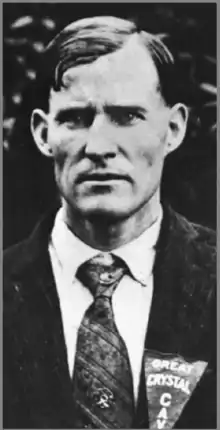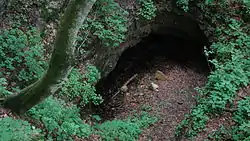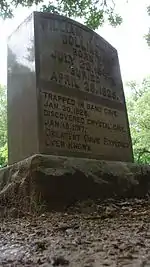Floyd Collins
William Floyd Collins (July 20, 1887 – c. February 13, 1925), better known as Floyd Collins, was an American cave explorer, principally in a region of Central Kentucky that houses hundreds of miles of interconnected caverns within Mammoth Cave National Park, the longest cave system in the world. In the early 20th century, in an era known as the Kentucky Cave Wars,[1] commercial cave owners and explorers in Kentucky entered into a bitter competition to exploit the bounty of caves for commercial profit from tourists, who paid to see the caves. In 1917, Collins had discovered and commercialized Crystal Cave on Flint Ridge (now part of the Mammoth Cave System but at the time an isolated cave). But the cave was remote and visitors were few. Collins had an ambition to find another cave he could open to the public closer to the main roads, and entered into an agreement with a neighbor to open up Sand Cave, a small cave on the neighbor's property. On January 30, 1925, while working to enlarge the small passage in Sand Cave, Collins became trapped in a narrow crawlway 55 feet (17 m) below ground. The rescue operation to save Collins became a national newspaper sensation and one of the first major news stories to be reported using the new technology of broadcast radio. The rescue attempt grew to become the third-biggest media event between the world wars.
Floyd Collins | |
|---|---|
 | |
| Born | July 20, 1887 Auburn, Kentucky United States |
| Died | c. February 13, 1925 (aged 37) Cave City, Kentucky, United States |
| Resting place | Mammoth Cave Baptist Church Cemetery, Mammoth Cave, Kentucky |
| Occupation | Cave owner, cave explorer |
| Known for | Cave exploration in Central Kentucky; being trapped in Sand Cave and dying before a rescue party could get to him |
After four days, during which time rescuers were able to bring water and food to Collins, a rock collapse in the cave closed the entrance passageway, stranding him in the cave, except for voice contact, for more than two weeks. Collins died of thirst and hunger compounded by exposure through hypothermia after being isolated for 14 days, just three days before a rescue shaft reached his position. Collins' body would be recovered two months later.
Although Collins was an unknown figure in his lifetime, the fame he gained from his death led to him being memorialized on his tombstone as the "Greatest Cave Explorer Ever Known". [2]
Early life
William Floyd Collins was born in Auburn, Logan County, Kentucky, the son and third child of Leonidas Collins and Martha Jane Burnett. Collins had five brothers, James, Floyd (a brother with same name), Andy Lee, Marshall Everett and Homer Larkin, as well as two sisters, Anna and Nellie.
Crystal Cave

In the period of Kentucky history known as the "Cave Wars," the Floyd Collins family owned their own cave called Crystal Cave, a tourist show cave in the karst region of Mammoth Cave. Crystal Cave attracted a low number of tourists due to its remote location. Collins hoped to find another entrance to the Mammoth Cave or possibly an unknown cave along the road to Mammoth Cave and draw more visitors and greater profits. He made an agreement with three farmers, who owned land closer to the main highway. If he found a cave, they would form a business partnership and share in the responsibilities of operating this tourist attraction. Working alone, within three weeks, he had explored and expanded a hole that would later be called "Sand Cave" by the news media.
1925 cave accident
On January 30, 1925, after several hours of work, Floyd Collins managed to squeeze through several narrow passageways; he claimed he had discovered a large, grotto chamber, though this was never verified. Because his lamp was dying, he had to leave quickly before losing all light to the chamber, but became trapped in a small passage on his way out. Collins accidentally knocked over his lamp, putting out the light, and was caught by a rock from the cave ceiling, pinning his left leg. The falling rock weighed 26 pounds; rescuers were unable to reach the rock to remove it.
Floyd Collins was trapped 150 feet (50 m) from the entrance. After being found the next day by a friend, crackers were sent to him and an electric light was run down the passage to provide him lighting and some warmth. Collins survived for more than a week while rescue efforts were organized. On February 4, the cave passage collapsed in two places. Rescue leaders, led by Henry St. George Tucker Carmichael, determined the cave impassable and too dangerous and began to dig a shaft to reach the chamber behind Collins.[3] The 55-foot (18 m) shaft and subsequent lateral tunnel intersected the cave just above Collins, but when he was finally reached on February 17, he was already dead from exposure. Because he could not be reached from behind, the rescuers could not free his leg. They left his body in place and filled the shaft with debris. A doctor estimated he had died three or four days before he was reached, with February 13 the most likely date.
Media attention
Newspaper reporter William Burke "Skeets" Miller from The Courier-Journal in Louisville reported on the rescue efforts from the scene. Miller, of small stature, was able to remove a lot of earth from around Collins. He also interviewed Collins in the cave, receiving a Pulitzer Prize for his coverage[4] and playing a part in Collins' attempted rescue. Miller's reports were distributed by telegraph and were printed by newspapers across the country and abroad, and the rescue attempts were followed by regular news bulletins on the new medium of broadcast radio (the first broadcast radio station KDKA having been established in 1920). Shortly after the media arrived, the publicity drew crowds of tourists to the site, at one point numbering in the tens of thousands. Vendors set up stalls to sell food and souvenirs, creating a circus-like atmosphere. The Sand Cave rescue attempt grew to become the third-biggest media event between the world wars. (The biggest media events of that time both involved Charles Lindbergh — the trans-Atlantic flight and his son's kidnapping — and Lindbergh actually had a minor role in the Sand Cave rescue, too, having been hired to fly photographic negatives from the scene for a newspaper.)[4] Since the nearest telegraph station was in Cave City, some miles from the cave, two amateur radio operators with the callsigns 9BRK and 9CHG provided the link to pass messages to the authorities and the press.[5]
Burial and exhibition of body

With Collins's body remaining in the cave, funeral services were held on the surface. Homer Collins was not pleased with Sand Cave as his brother's grave, and two months later, he and some friends reopened the shaft. They dug a new tunnel to the opposite side of the cave passage and recovered Floyd Collins's remains on April 23, 1925.[4] The following day, the body was buried in the burial ground of the Collins family's farm,[4] near Crystal Cave, now known as "Floyd Collins Crystal Cave." In 1927, Floyd Collins' father, Lee Collins, sold the homestead and cave. The new owner placed Collins' body in a glass-topped coffin and exhibited it in Crystal Cave for many years.[4][6] On the night of March 18–19, 1929, the body was stolen. The body was later recovered, having been found in a nearby field, but the injured left leg was missing.[4][6] After this desecration, the remains were kept in a secluded portion of Crystal Cave in a chained casket. In 1961, Crystal Cave was purchased by Mammoth Cave National Park and closed to the public.[6] The Collins family had objected to Collins' body being displayed in the cave and, at their request, the National Park Service re-interred him at Mammoth Cave Baptist Church Cemetery, Mammoth Cave, Kentucky in 1989.[4][6] It took a team of 15 men three days to remove the casket and tombstone from the cave.
Later exploration
The attention over the rescue attempt of Collins created interest in the creation of Mammoth Cave National Park, of which Sand Cave is now a part. Fear and superstition kept cavers away from Sand Cave for decades. The National Park Service has sealed the entrance with a steel grate for public safety. Expeditions into Mammoth Cave showed that portions of Mammoth actually run under Sand Cave, but no connection has ever been discovered. In the 1970s, cave explorer and author Roger Brucker and a small group entered Sand Cave to conduct research for a book about Collins. The team surveyed Sand and discovered an opening in the collapsed tunnel through which a smaller caver can crawl, showing that it would have been possible to feed and heat Collins after February 4, 1925. They proceeded as far as the passage where Collins was trapped; it was choked with gravel and unsafe to excavate. In April 1983, George Crothers led an archaeological investigation that documented many 1925 artifacts in the cave. These were removed for future preservation.
In popular culture
The life and death of Collins inspired the musical Floyd Collins by Adam Guettel and Tina Landau,[7] as well as one film documentary, several books, a museum and many short songs. Ace in the Hole (alternative title, The Big Carnival) is a 1951 film by Billy Wilder based on the media circus surrounding the attempted rescue of a man stuck in a cave. The film depicts a fictional incident, but Collins is mentioned by name in the dialogue. He is mentioned in two novels by Kentucky writers Robert Penn Warren and James Still: The Cave and River of Earth.
In 2006, actor Billy Bob Thornton optioned the film rights to Trapped! The Story of Floyd Collins and a screenplay was adapted by Thornton's writing partner, Tom Epperson. However, Thornton's option expired and the film rights were acquired by producer Peter R. J. Deyell in 2011.[8]
Fiddlin' John Carson and Vernon Dalhart recorded "The Death of Floyd Collins"[9] in 1925. Kentucky-based rock band Black Stone Cherry has a song titled "The Ghost of Floyd Collins" on their 2008 album, Folklore and Superstition. John Prine and Mac Wiseman released a song titled "Death of Floyd Collins," written by Andrew Jenkins, on their 2007 album Standard Songs For Average People.
Floyd Collins is mentioned in Mark Z. Danielewski's postmodern novel House of Leaves (p 334 of the Pantheon Books 2nd edition).
The story of Floyd Collins is also included in the novel Supernatural: The Usual Sacrifices by Yvonne Navarro.[10]
The poet Clark Coolidge's 1978 book Own Face (United Artists) features a photo of Floyd Collins on the cover and a number of poems in the book make reference to Collins, caving, and related matters. Sun & Moon Press published an edition of Own Face in 1993.
The story of Floyd Collins' death is mentioned on the television show The Blacklist.
See also
- Moose River Disaster, mine cave-in covered extensively on radio in 1936
References
- Cave Wars - Mammoth Cave National Park (U.S. National Park Service)
- Murray & Brucker, Robert & Roger (1979). Trapped. G.P. Putnams Sons. ISBN 0399123202.
- "Cave floor expands and entombs Collins". Journal and Courier. February 5, 1925. p. 1. Retrieved December 28, 2017 – via Newspapers.com.

- Bukro, Casey (March 26, 1989). "Folk hero's burial ends 3 generations of anguish". Chicago Tribune. p. 19. Retrieved December 28, 2017 – via Newspapers.com.

- DeSotto, Clinton: 200 Meters & Down - The Story of Amateur Radio, 1936 - American Radio relay League p.162 ISBN 978-0-87259-001-4
- Bukro, Casey (March 26, 1989). "Folk hero's burial ends 3 generations of anguish 2". Chicago Tribune. p. 20. Retrieved December 28, 2017 – via Newspapers.com.

- "Blackfriars goes undergrsound for new musical". Democrat and Chronicle. May 3, 2002. p. 19. Retrieved December 28, 2017 – via Newspapers.com.

- "Floyd Collins Book Acquired by Producer Peter R.J. Deyell". Broadway World. 2011-04-26. Retrieved 2011-06-26.
- "The Death of Floyd Collins (Edison Blue Amberol: 5049)". 1925.
- Navarro, Yvonne (2017). Supernatural: The Usual Sacrifices. Titan Books. p. 194. ISBN 978-1-7832-9857-0.
- Brucker, R. and Murray, R. Trapped! the Story of Floyd Collins, University Press of Kentucky, 1983. ISBN 0-8131-0153-0
- Collins, Homer. The Life and Death of Floyd Collins, as told to Jack Lehrberger, Cave Books, 2009. ISBN 0-9397-4847-9
"Supernatural: The Usual Sacrifices" By Yvonne Navarro, Titan Books, 2017 ISBN 9781783298570
External links
| Wikimedia Commons has media related to Floyd Collins. |